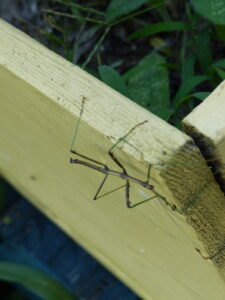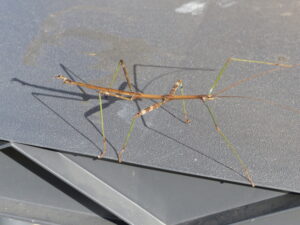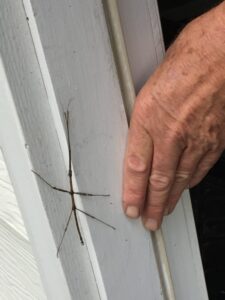Imagine how embarrassing it would be to be caught stark naked in public. Maybe that’s how the Walking Stick, a huge insect, felt that we spotted clinging to a shelf outside our house.
About 3000 species of Walking Sticks live worldwide. All love hiding. Their camouflage is almost perfect. No doubt the one we discovered would have been far more comfortable clinging nearly invisible on tree bark.
Although common and huge some species can be upwards of 20 inches long! They’re nearly impossible to spot as they lurk on twigs and bark. We likely walk right by many. They simply hide in plain sight. The name of their order is Phasmatodea, meaning apparition. It perfectly describes them.
The one we spotted must have been lost. Rather than comfortably blending into the woods our gangly stick-looking insect contrasted against our shelf as naked as a jaybird. We couldn’t miss spotting it.
Herbivorous Walking Sticks spend nights munching on leaves and rest during daylight. Females are usually bigger than males and usually just drop their eggs to the ground. Growth is slow, and the babies can take three to 12 months to mature. That’s glacial growth for an insect, but they can live for two years if not devoured by birds, small mammals, or predatory insects. Insecticides devastate them.
Walking Sticks don’t bite or sting and are one of the thousands of nature’s wonders to discover in an ecologically healthy yard. They’re downright fascinating and fun to share with children.
- Easy to see
- A large herbivore.
- Walking Sticks are easy to spot on plain backgrounds.





Love the article about walking sticks. I believe we have had some here, but I can only say that in a maybe sort of way.
They certainly are unique.